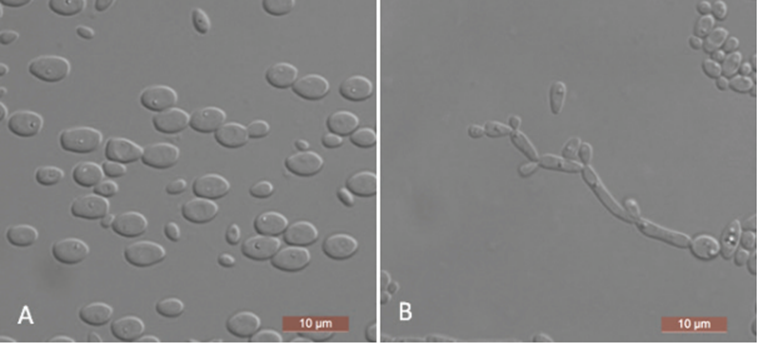 120
120
Yamadazyma ovata C.Y. Chai & F.L. Hui, sp. nov.2021
MycoBank No: 840100
Holotype NYNU 191125T
Morphological description :
Asexual morph: The cells are ovoid to ellipsoid (2–3 × 3–6.5 µm) and occur singly or in pairs after growth in a YM broth for three days at 25 °C (Figure 3A). Budding is multilateral. After three days of growth on YM agar at 25 °C, the colonies are white to cream-colored, buttery, and smooth with entire margins. After nine days at 25 °C, on a Dalmau plate culture with CM agar, pseudohyphae consisting of elongated cells with lateral buds are formed (Figure 3B). True hyphae are not observed. Asci or signs of conjugation are not observed on sporulation media. Glucose, galactose, and trehalose are fermented, but maltose, sucrose, melibiose, lactose, cellobiose, melezitose, raffinose, d-xylose, and inulin are not. Glucose, galactose, l-sorbose, d-glucosamine, d-ribose, d-xylose, l-arabinose, d-arabinose, sucrose, maltose, trehalose, methyl α-d-glucoside, cellobiose, salicin, melibiose, melezitose, glycerol, erythritol, ribitol, xylitol, d-glucitol, d-mannitol, d- galactitol, d-glucono-1, 5-lactone, 2-keto-d-gluconate, d-gluconate, succinate, citrate, and ethanol are assimilated. No growth is observed in l-rhamnose, lactose, raffinose, inulin, myo-inositol, d-glucuronate, dl-lactate, or methanol. In nitrogen-assimilation tests, growth is present on l-lysine, creatine, glucosamine, and d-tryptophan, while growth is absent on nitrate, nitrite, ethylamine, cadaverine, creatinine, or imidazole. Growth is observed at 37 °C, but not at 40 °C. Growth in the presence of 16% NaCl with 5% glucose is present, but growth in the presence of 0.01% cycloheximide and 1% acetic acid is absent. Starch-like compounds are not produced. Urease activity and diazonium blue B reactions are negative.
sexual morph :not observed.
Culture characteristics:
Habitat: in rotting wood from a forest park,
Distribution: China, Henan Province, Luoyang City, Song County,
GenBank: Holotype NYNU 191125T (ITS: MT990560; D1/ D2 LSU: MT990559); additional isolates NYNU 19116 (ITS: MZ318442; D1/D2 LSU: MZ318423), and NYNU 19130 (ITS: MZ318424; D1/D2 LSU: MZ318425).
based on growth in l-sorbose, d-glucosamine, melibiose, and d-glucono-1, 5-lactone, all of which are positive for Y. ovata and negative for C. trypodendroni (Table 2) (Lachance et al. 2011)
Reference: [1] Limkaisang, S. , Kom-Un, S. , Furtado, E. L. , Liew, K. W. , Salleh, B. , & Sato, Y. , et al. (2005). Molecular phylogenetic and morphological analyses of oidium heveae, a powdery mildew of rubber tree. Mycoscience, 46(4), 220-226.

Yamadazyma ovata (NYNU 191125, holotype) A budding cells after three days in YM broth at 25 °C B pseudohyphae on cornmeal agar after nine days at 25 °C. Scale bars: 10 µm.

